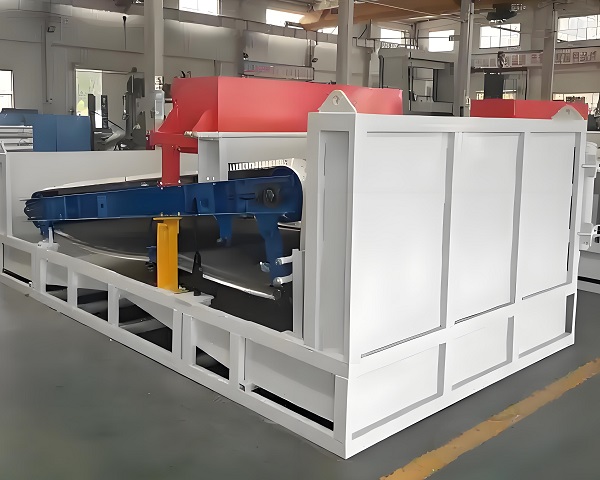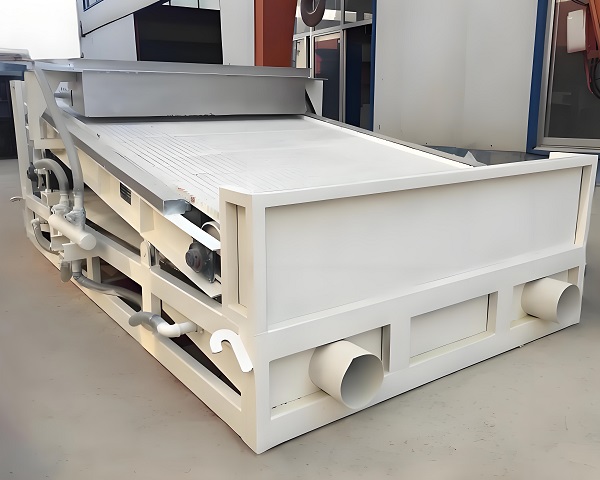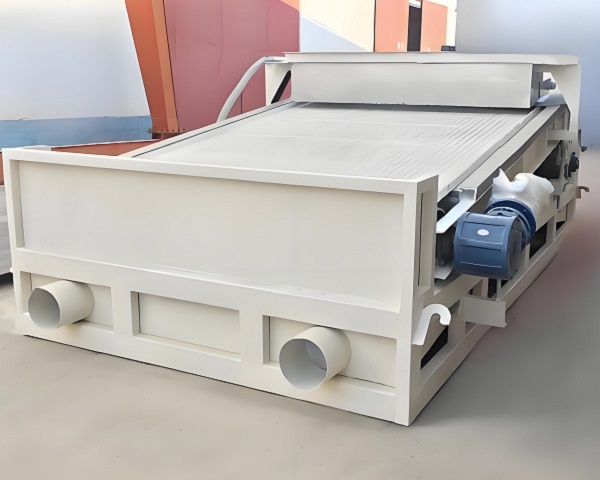In industrial material handling, efficient separation and purification are crucial for ensuring product quality and improving resource utilization. Traditional separation methods are often limited by efficiency and precision, making them difficult to adapt to the diverse needs of various industries. Magnetic separators, relying on the unique effect of magnetic fields on magnetic materials, achieve impurity removal and mineral extraction, becoming core equipment in mining, metallurgy, and environmental protection. A thorough analysis of their applications and characteristics is of significant practical importance for enterprises to optimize production processes and practice green development.
In the material purification and separation stages of industrial production, magnetic separation equipment, with its unique magnetic separation principle, has become an indispensable key device. Magnetic separators utilize the adsorption and separation effect of magnetic fields on magnetic materials to remove magnetic impurities or extract magnetic minerals, and are widely used in multiple industries. The applications and characteristics of magnetic separators will be detailed below.
Applications of Magnetic Separators

Based on the force of magnetic fields on magnetic materials, combined with a reasonable equipment structure and operating parameters, magnetic separators can achieve precise separation for different material characteristics. Their applications cover multiple fields such as mining, metallurgy, environmental protection, and food processing.
1. Mining Industry
The mining industry is one of the most widespread applications of magnetic separators, primarily for the separation and purification of magnetic minerals. In iron ore mining and processing, magnetic separators can separate magnetic iron minerals from raw iron ore, remove non-magnetic impurities such as gangue, and increase the iron content of the iron ore, providing high-quality iron concentrate for subsequent smelting processes. For example, in magnetite beneficiation, after coarse crushing and grinding, the iron ore enters a magnetic separator. The magnetic field adsorbs the magnetic iron minerals onto the surface of the magnetic drum, and as the drum rotates, they fall off in the non-magnetic zone, thus separating the iron minerals from the gangue. The iron concentrate grade can be increased to over 60%. Furthermore, magnetic separators also play an important role in the processing of other magnetic minerals such as manganese and chromium ores. By adjusting the magnetic field strength and equipment operating parameters, magnetic components in the minerals can be separated, improving the purity and value of the mineral products.
2. Metallurgical Industry
In metallurgical production, magnetic separators are mainly used for raw material purification, by-product recovery, and removal of metallic impurities. In steel smelting, ferromagnetic impurities may be mixed in with raw materials (such as coke and limestone). If not removed, these impurities can affect smelting quality and damage equipment. Magnetic separators can pre-treat these raw materials, adsorbing and removing magnetic impurities to ensure the purity of the raw materials. Simultaneously, in the treatment of by-products of steel production (such as steel slag), magnetic separators can recover residual iron metal from the slag, achieving resource recycling and reducing production costs. In the non-ferrous metal smelting field, some non-ferrous metal minerals (such as magnetic minerals in copper-nickel ore) can be pre-sorted using magnetic separators to remove magnetic impurities, improving the efficiency of subsequent flotation processes and ensuring the quality of non-ferrous metal products.
3. Environmental Protection Industry With increasingly stringent environmental protection requirements, magnetic separators are increasingly widely used in the environmental protection field, mainly for wastewater treatment and solid waste recycling. In industrial wastewater treatment, many factories (such as electroplating plants and steel mills) produce wastewater containing magnetic suspended solids or magnetic pollutants. Magnetic separators can purify wastewater by adding magnetic flocculants to the wastewater, causing the pollutants to bind with magnetic particles, and then using a magnetic field to adsorb and separate them. For example, in the treatment of cold rolling wastewater in steel mills, magnetic separators can effectively remove ferromagnetic oxides from the wastewater, allowing it to meet discharge standards or be recycled. In solid waste treatment, magnetic separators can separate ferromagnetic materials (such as scrap iron and steel rebar fragments) from domestic waste and industrial slag, achieving resource recovery, reducing solid waste landfill volume, and lowering environmental pollution. Furthermore, in the treatment of fly ash from coal-fired power plants, magnetic separators can extract magnetic iron oxide from fly ash for use in the production of magnetic materials or as a building material additive, improving the resource utilization rate of fly ash.

4. Food Processing Industry The food processing industry has extremely high requirements for the purity and safety of raw materials. Magnetic separators are mainly used to remove magnetic impurities from food raw materials, ensuring food quality and safety. In grain processing (such as wheat and rice processing), raw materials may contain magnetic impurities such as iron nails and wires during harvesting and transportation. If these impurities enter processing equipment, they can damage the machinery, and if they enter food, they can harm human health. Magnetic separators can be installed in grain processing production lines to magnetically separate the raw materials, adsorbing and removing these magnetic impurities, ensuring the safety and smooth operation of grain processing. Magnetic separators also play an important role in the oil processing and sugar refining industries, removing magnetic impurities from raw materials (such as soybeans and sugarcane) to prevent them from affecting product quality and ensuring that food meets relevant safety standards.
5. Building Materials Industry In the building materials production process, magnetic separators are mainly used for raw material purification and product quality control. In cement production, cement raw materials (such as limestone and clay) may contain ferromagnetic impurities. These impurities can affect the strength and performance of cement and also wear down cement production equipment (such as ball mills). Magnetic separators can magnetically separate cement raw materials to remove these magnetic impurities, ensuring cement quality and the normal operation of production equipment. In ceramic and glass production, ferromagnetic impurities in raw materials can cause defects such as discoloration and bubbles in the products. Magnetic separators can precisely separate and remove magnetic substances from the raw materials, improving the appearance quality and performance of ceramic and glass products and meeting the demands of the high-end building materials market.
Features of Magnetic Separators

1. Scientific Structural Design: Magnetic separators employ a scientifically designed and rationally structured structure, ensuring overall stability and reliability, and adaptability to various production conditions. Core components (such as the magnetic drum and magnetic system) are made of high-strength materials, and the surface of the magnetic drum undergoes special treatment, providing excellent wear resistance and corrosion resistance, extending the equipment's service life. The magnetic system uses high-quality permanent magnet materials or electromagnetic coils, ensuring stable and uniform magnetic field strength and effective separation. Furthermore, the inlet and outlet designs of the magnetic separator are reasonable, allowing adjustment of the feeding speed and discharge method according to production needs, facilitating integration with other equipment to form a production line. In addition, the equipment frame is constructed of welded steel, providing high rigidity and minimizing vibration during operation, ensuring the stability and safety of the equipment.
2. High Separation Efficiency: Magnetic separators achieve extremely high separation efficiency thanks to their stable magnetic field performance and optimized operating parameters. Its magnetic system is precisely calculated, and the magnetic field strength can be adjusted according to the material characteristics, ranging from hundreds to tens of thousands of gauss, effectively adsorbing substances with varying magnetic strengths. During operation, the material's trajectory within the equipment is optimized, ensuring full contact with the magnetic field. Magnetic substances are rapidly adsorbed and separated, while non-magnetic substances are smoothly discharged, achieving a separation efficiency of over 90%. For example, in iron ore beneficiation, for strongly magnetic magnetite, a single magnetic separator can achieve a high recovery rate; for weakly magnetic hematite, ideal separation results can also be achieved with appropriate pretreatment processes. Furthermore, the magnetic separator has a large processing capacity, with single-unit capacity ranging from several tons/hour to hundreds of tons/hour, meeting the production needs of enterprises of different sizes.
3. High Separation Precision The magnetic separator achieves high-precision separation of materials by precisely controlling the magnetic field distribution and equipment operating speed. Its magnetic system employs multi-layer arrangement or a special magnetic field design to ensure uniform distribution of the magnetic field within the effective separation area, avoiding magnetic dead zones and guaranteeing full adsorption of magnetic substances. The rotation speed of the magnetic drum can be precisely adjusted according to the particle size and magnetic strength of the material. Too high a speed will cause magnetic materials to detach before being fully adsorbed, while too low a speed will affect processing efficiency. A reasonable speed setting allows for precise separation of magnetic and non-magnetic materials. In industries with extremely high requirements for impurity removal, such as food processing and pharmaceuticals, magnetic separators can remove tiny magnetic impurities (such as micron-sized iron filings) from materials, ensuring product purity meets stringent standards.
4. Stable and Reliable Operation The transmission system of the magnetic separator uses high-quality motors, bearings, and reducers, combined with precise manufacturing processes, resulting in smooth operation and a low failure rate. The permanent magnet magnetic separator uses high-performance permanent magnet materials, resulting in slow magnetic field attenuation, long service life, and no need for frequent maintenance. The electromagnetic magnetic separator uses high-temperature resistant, well-insulated wires for its electromagnetic coils, combined with a reliable electrical control system, to stably output the magnetic field. Furthermore, the equipment's lubrication system is well-designed, with key components lubricated regularly to reduce mechanical wear and extend the equipment's service life. Furthermore, magnetic separators possess excellent overload capacity, maintaining stable operation even under short-term fluctuations in feed volume, ensuring continuous production.

5. Energy Saving and Environmental Protection
In terms of energy consumption, magnetic separators utilize highly efficient and energy-saving motors, resulting in low power consumption during operation. Compared to traditional separation equipment (such as gravity separation equipment), energy consumption is reduced by 30%-50%. Permanent magnet magnetic separators do not require electrical energy to generate a magnetic field; only a motor is needed to drive the equipment, further reducing energy consumption. Regarding environmental protection, magnetic separators do not use chemical agents during the separation process, producing no wastewater, exhaust gas, or other pollutants, meeting green production requirements. Simultaneously, by recovering and utilizing magnetic materials in the materials (such as recovering scrap iron from waste residue), resource recycling is achieved, reducing solid waste emissions and lowering environmental pressure.
6. Strong Adaptability
Magnetic separators can adapt to the separation needs of different types and properties of materials. Whether it is granular, powdery, or lumpy materials, or magnetic impurities in liquid materials, they can be effectively separated. By changing the type of magnetic system (e.g., permanent magnet system, electromagnetic system), adjusting the magnetic field strength, and modifying the equipment structure (e.g., drum type, disc type, cylindrical type), the special needs of different industries such as mining, metallurgy, environmental protection, and food can be met. For example, when processing coarse-particle materials, a large-diameter feed drum type magnetic separator can be selected; when processing fine powder materials, a disc type magnetic separator can be used to improve separation accuracy. Furthermore, magnetic separators can operate in different working environments, such as high temperature, humidity, and dusty conditions, and can maintain good operating performance by taking appropriate protective measures (e.g., sealing, heat dissipation).
Magnetic separators play an important role in many industries, including mining, metallurgy, environmental protection, food processing, and building materials, due to their wide range of applications and excellent characteristics. With the continuous development of industrial technology, higher demands are being placed on the separation efficiency, precision, and environmental performance of magnetic separators. In the future, magnetic separators will develop towards intelligence (e.g., equipped with automatic control systems to automatically adjust magnetic field strength and rotation speed), large-scale production (to meet the needs of large-scale production), and multi-functionality (to achieve the combined separation of multiple materials), providing stronger support for the green, efficient, and high-quality development of industrial production. In practical applications, enterprises should rationally select and use magnetic separators based on their own material characteristics, production needs, and working environment to fully leverage their advantages, improve production efficiency and product quality, and reduce production costs.
Magnetic separators, based on the principle of magnetic field separation, play a crucial role in multiple industries: they can assist in mineral purification and metallurgical resource recovery, as well as promote environmental solid waste treatment and food safety assurance. Their scientific structure, high-efficiency and precise separation, stable operation, and energy-saving and environmentally friendly characteristics solve traditional separation problems. With industrial upgrading, magnetic separators are developing towards intelligence and large-scale production, and will be more adaptable to complex working conditions in the future, providing strong support for cost reduction, efficiency improvement, and sustainable development in various industries.